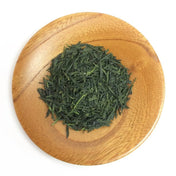Boil water, make tea, drink
Tea. Sen no Rikyu (1522-1591), the seminal master of Chanoyu (the “Japanese tea ceremony”), famously said, “All you must know about Chanoyu is simply this: boil the water, make the tea, and drink.” (The more commonly used translation is “The Way of Tea is naught but this: first you boil water, then you make the tea and drink it.”)
茶の湯とはただ湯をわかし茶を点ててのむばかりなることと知るべし
Chanoyu to ha tada yu wo wakasi cha wo tatete nomu bakari naru koto to shiru beshi
Basic guidelines
The simplest guidelines for steeping (we use the term "brewing" to mean boiling tea in water to extract flavor) Japanese green tea are this: Take 5 grams of tea, steep it in 200 ml hot water (70C/160F degrees) for about one minute. This is often what we put on Yunomi labels (though not always), and a basic guideline
Tea: 5 grams. Time: 60 seconds.
Water temperature: 70C/160F degrees. Water amount: 200 ml.
When making Japanese green tea, you generally don't make a large pot of tea, but a small pot, just enough for one cup (200 ml) or two sencha cups (100 ml) for two people. When you finish drinking your cup, you steep a second and third time. Combining multiple steeps may average out the flavor, but is an easy way to make a large amount of tea from one single serving of leaves.
Temperature is important!
Remember that water at hotter temperature extracts more, but the bitter flavors (i.e. caffeine and catechin) overwhelm sweet/umami flavors (L-theanine)
Water at cooler temperature extracts sweet/umami flavors without extracting the bitter flavors (which is why cooler temperatures are often used for high grade sencha, kabusecha, and gyokuro teas).
Do you need a thermometer? It doesn't hurt to use one. But drinking daily, it's not always practical. Instead remember this rule of thumb, allowing water to heat up a ceramic container generally decreases its temperature by about 10C/18F degrees. So if you have boiling water, warming up your pot, then your cups cools it down to 80C degrees. You may also use a second pot (or cooling bowl)
Tea amount, water amount
In addition to adjusting the temperature, increasing the amount of tea or decreasing the amount of water results in a more concentrated tea.
Time
While most non-Japanese green teas often require 3-5 minutes steeping time, most Japanese green teas are made to be steeped in 1 minute or less. The finer (more powdery) the leaf itself is, the more likely that it will steep more quickly. A hotter temperature will also extract flavor more quickly. If you are looking for a lighter flavor, use less tea or steep for a much quicker amount of time.
Steeping at cooler temperatures will extract flavor from the tea leaf more slowly, and so a longer steeping time is recommended in such cases.
Techniques for one serving at a time
Note to make a larger amount, multiplying the parameters will work but you may need to adjust depending on the tea. You may also make a larger amount by combining several steeps into one serving. (i.e. Three 200 ml steeps for 600 ml.) 1 cup = about 240 ml. or 100 ml = about 0.4 cups / 3.4 fl oz.
Remember, these techniques are guidelines meant to start you off. Depending on your own personal taste, the water type you have available, and of course the specific tea leaves, you should learn to adjust the water amount, temperature, tea leaf amount and steep time to achieve your perfect cup of tea.
Making tea for several guests at once? Follow these guidelines to impress!
Gyokuro, Kabusecha, Tencha
玉露、かぶせ茶、碾茶の淹れ方
The characteristic of shaded green tea leaves -- gyokuro, kabusecha, tencha -- are their enhanced umami flavors. To enjoy those umami flavors to the fullest, your first steep can be made at a low temperature. Unshaded, but very high grade sencha may also be uniquely delicious at lower temperatures too. Feel free to experiment!
Tea: 5g. Time: 2-3 min. Water: 50C/122F, 60-80 ml (Water should just cover the leaves). Resteep 2nd time at 15 sec., 80C/176F, 200 ml. Resteep 3rd time at 45 sec., 80C/176F, 200 ml.
Premium Sencha
高級煎茶の淹れ方
These teas also have more umami flavor, so steeping is generally recommended at low temperature helps you enjoy the sweet and umami components separately from the more bitter components which are extracted at higher temperatures. So we recommend starting with a low temperature first, and then increasing the temperature at subsequent steeps. But, if you would like to enjoy all the flavor components together, steep it at a higher temperature to start.
Tea: 5g. Time: 1-2 min. Water: 60C/140F, 100 ml. Resteep 2nd time at 15 sec., 80C/176F, 200 ml. Resteep 3rd time at 45 sec., 80C/176F, 200 ml.
Regular Sencha and other green teas
普通煎茶・緑茶の淹れ方
Tea: 5g. Time: 1 min. Water: 70C/158F, 200 ml. Resteep 2-3x at 80C/176F, 200 ml.
Fukamushicha, mecha, konacha
深蒸茶、芽茶、粉茶の淹れ方
The small size of these leaves mean that they steep (flavor is extracted) very quickly.
Tea: 3g. Time: 30 sec. Water: 70C/158F, 200 ml. Resteep 2-3x at 80C/176F, 200 ml.
Tips: use less tea for a lighter flavor. Use hotter water for more bitterness (cooler for more sweetness), and use hotter water for a deeper green color.
Bancha, genmaicha, hojicha
番茶、玄米茶、ほうじ茶などの淹れ方
These tend to be based on a lower grade leaf (bancha) which is larger, thicker, and extracts flavor less quickly. Hotter water and longer steeping times are used as a result. However, some genmaicha and some hojicha (roasted tea, generally roasted green tea) may be using high grade leaf which steeps faster.
Tea: 5g. Time: 30-60 sec. Water: 90C/194F, 200 ml. Resteep 3x.
More advanced steeping techniques
Steeping techniques for Green Teas (listed from cold to hot)
- Ice Steeping Technique
- Cold water steeping instructions
- Gyokuro Steeping Technique
- Warm Water Steeping Technique
- Standard Steeping Technique
- Kettle brewing technique

